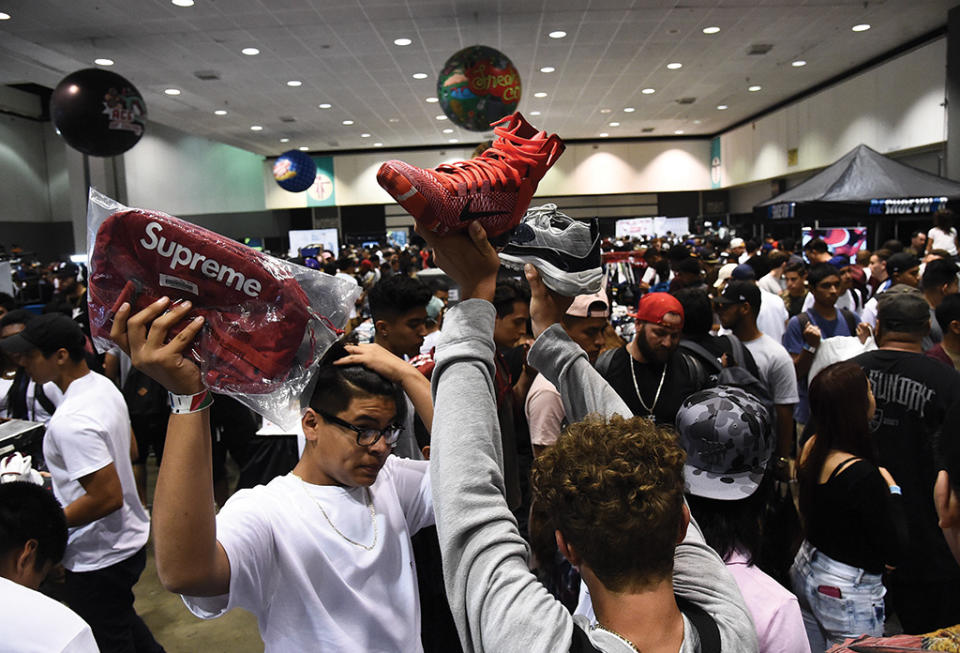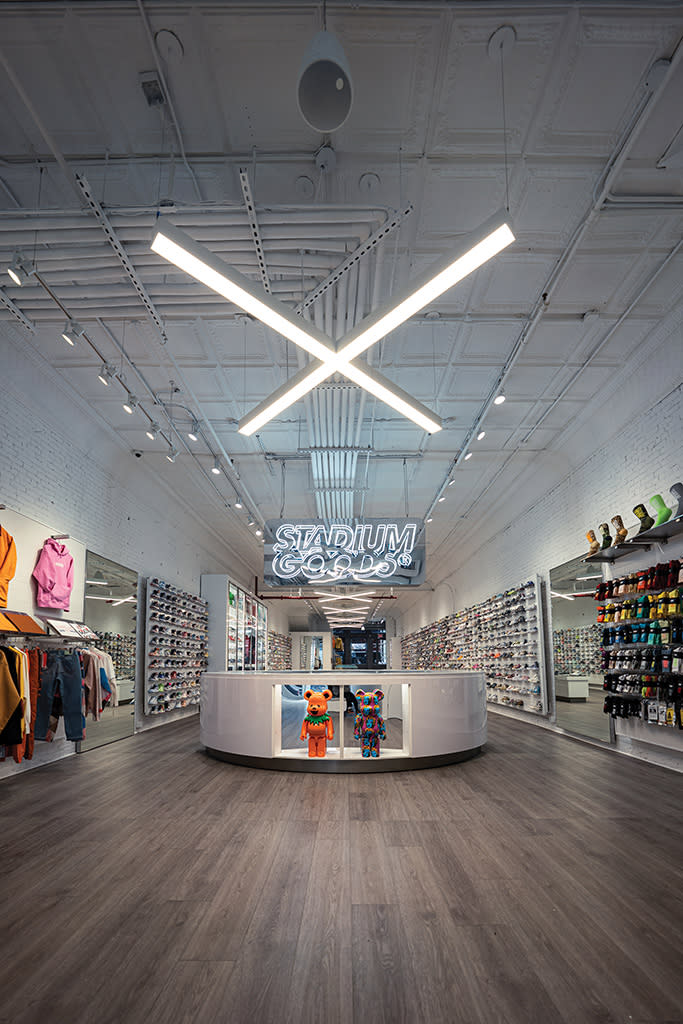Can the Secondhand Sneaker Market Make a Dent in Footwear’s Environmental Footprint?

Among sneaker fans, the concept of resale is far from new. Before there were sophisticated sites like StockX and GOAT — or even slick stores like Flight Club and Stadium Goods — diehard collectors were scouring eBay to find coveted sneakers for the lowest price and then reselling it to the highest bidder. The underlying drive was to make a quick buck — or simply enjoy the thrill of the hunt.
However, for those increasingly concerned about the environmental impact footwear is having on the planet, sneaker resale presents a welcome beacon — if it is indeed helping. How much are these platforms benefiting the environment?
More from Footwear News
DTC Nursing Shoe Brand Clove Is Expanding Into Wholesale & Adding New Styles
Marni Updates Mary Jane Style With a Sneaker-Inspired Spin for Fall 2023
The footwear industry has a well-established waste problem.
The U.S. Department of the Interior recently noted that Americans throw away at least 300 million pairs of shoes each year. These shoes end up in landfills, where they can take 30 to 40 years to decompose.
The issue balloons when you take into account the larger fashion universe. According to estimates from the U.S. Environmental Protection Agency, the amount of clothing and footwear waste generated by Americans each year has skyrocketed since 1960, growing 1.4 million tons that year to over 13 million tons in 2018, the most recent year the EPA has measured this data.
In order to curb this waste, many footwear companies have launched their own resale platforms via services like ThredUp, Trove and Recurate. Brands like Steve Madden, Dolce Vita, Allbirds, On, Rothy’s and Frye have all jumped on the peer-to-peer re-commerce bandwagon in an effort to reduce the number of shoes that end up in landfills.
THE SCOPE OF RESALE
For Andy Polk, SVP of the Footwear Distributors and Retailers of America (FDRA), the tipping point for the secondhand sneaker industry came in 2021, when Nike launched its own resale program.
“The stigma of buying secondhand and used sneakers was shed when Nike launched its own version of resale,” Polk told FN. “I think this was an important step in our industry. When a company with a lot of cultural gravitas like Nike has something to say about resale, it allowed other people to enter the market.”
James Reinhart, CEO of ThredUp, said in a statement in April, “Resale is starting to blossom globally, with many of the largest retailers in the world adopting more circular business models. While value continues to be a key driver that motivates consumers to think secondhand first, global climate issues have increased awareness of resale’s potential to reduce fashion’s impact on the environment.”

Blossoming it is, indeed. According to its 2023 Resale Report, ThredUp found that the global secondhand market is set to nearly double by 2027, reaching $350 billion, with the U.S. secondhand market alone expected to reach $70 billion that same year.
For footwear specifically, the most recent data from Cowen & Co. estimates that the global sneaker resale market was valued at $6 billion in 2019 and it is forecast to reach $30 billion by 2030.
When it comes to how sneaker resale is benefiting the planet, Eric Mesa, co-founder and COO of sneaker recycling company GotSneakers, told FN that it’s a complex question with no easy answer.
“We believe diverting sneakers from landfills and extending the lifecycle through reuse absolutely benefits the environment,” he said. “Keeping used sneakers in circulation creates more consumer awareness and demand for secondhand sneakers.”
However, Mesa added, as the secondhand market grows, brands should start to rethink their production plans for new product. “The bulk of carbon emissions associated with a pair of sneakers occurs during the manufacturing process, so reducing the number of new sneakers that are produced each year will have a direct impact on the reduction of carbon emissions from the footwear industry,” the executive said.
Polk agreed with this idea, citing the manufacturing process as the industry’s biggest pollution offender. “If the strategy becomes to reduce the number of pairs made of virgin material at the factories and to create new models or revenue streams using existing product, then that makes sense for a positive environmental impact,” Polk said. “Because 70 percent or so of the impact of the shoe was made at the beginning of the manufacturing process. So let’s keep the sneakers out of landfills. Let’s keep them in circulation as long as we can.”
THE PROBLEMS IN PRODUCTION
According to sustainability consultancy Quantis, sneaker production is exceptionally carbon intensive, accounting for 1.4 percent of the global greenhouse gas emissions.
In fact, a study conducted by MIT in 2013 found that a typical pair of running shoes generates approximately 13.6 kilograms of CO2 emissions, the bulk of which come from manufacturing. While a large part of the carbon footprint is contributed by a facility’s energy source, other emissions come from processes such as foaming and injection molding parts of a sneaker’s sole — which expend large amounts of energy to make relatively small, lightweight parts. As Randolph Kirchain, principal research scientist in MIT’s Materials Systems Laboratory, said in the report: “You have a lot of effort going into the molding of the material, but you’re only getting a very small part out of that process.”

Asked what steps need to be taken to make the sneaker industry more sustainable, GotSneakers’ Mesa had several suggestions. These included improving logistics infrastructure to divert more sneakers from landfills, thereby increasing the number of sneakers available for resale; requiring businesses to operate more efficiently and meet certain energy, water and waste reduction targets will help the industry become more sustainable; and educating consumers about the environmental impact of sneaker resale will enable consumers to make more informed decisions when shopping for sneakers.
“We also need more end-of-life solutions, such as grinding sneakers to reuse raw materials like rubber, foam, textile and plastic. That will play an important role in making the sneaker industry more sustainable,” Mesa noted.
The GotSneakers executive added that enhancing traceability and transparency, clarifying producer responsibilities from origin, and expanding mass-scale recycling to repurpose and recirculate valuable materials into other goods or back into the footwear industry could help foster a more sustainable and circular sneaker resale industry.
“Currently, the footwear industry faces challenges with unclear producer responsibility, high costs of deploying circular economy infrastructure and material recycling in the United States – leading to fragmented operations requiring materials to be shipped long distances to be processed,” Mesa added. “Establishing local hubs and domestic recycling infrastructure for these solutions will foster a truly circular and sustainable industry.”
Best of Footwear News
Sign up for FN's Newsletter. For the latest news, follow us on Facebook, Twitter, and Instagram.

